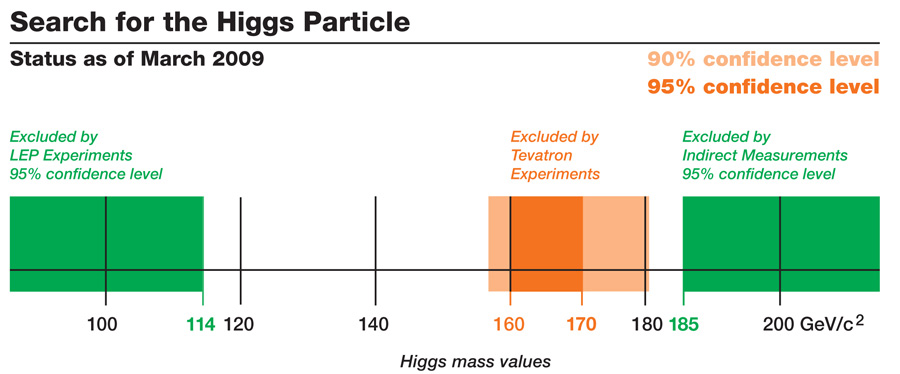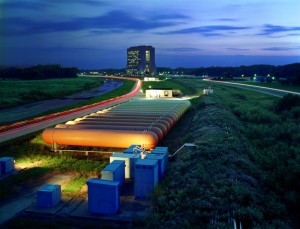Contact: Paul Preuss, (510) 486-6249, [email protected]
The two major experimental collaborations at Fermilab’s Tevatron, CDF and DZero, have joined forces to narrow the search for the Higgs boson. The as-yet undiscovered Higgs is the key to why particles have the masses they do, and is so significant to our understanding of nature that former Fermilab director Leon Lederman called it the “God particle.” Their results, released March 13, exclude a significant fraction of the allowed Higgs mass range. This indicates that the mass/energy of the Higgs may lie in a region where, with experimental improvements, it could perhaps be identified at Fermilab before it is found at CERN’s Large Hadron Collider (LHC).
Berkeley Lab physicists have long been important contributors to the international CDF collaboration, which currently includes 602 physicists from 15 countries. Berkeley Lab CDF group leader Lina Galtieri of the Physics Division and other members of the Lab’s CDF group are helping to zero in on the Higgs mass through its relationship to the top quark, while Wei-Ming Yao, also of Physics, is involved in the direct search for the Higgs, and in analyzing the combined dataset from both experiments.
Fermilab’s Tevatron is a proton-antiproton collider that, with an energy of about 2 TeV (two trillion electron volts, the combined energy of both counter-rotating beams), is the world’s most powerful accelerator until the LHC comes online later this year. The Tevatron’s principal experiments are DZero and CDF, whose distinguished history includes the 1995 discovery of the top quark, among many other advances.
“Usually the two teams are friendly competitors,” says Yao. “But to find something interesting about the Higgs we knew we needed to work together.”
“The two experiments have similar coverage, although probably they have better calorimetry and we have better tracking,” says Galtieri. “In searching for the Higgs, everything is needed – every piece of information that comes from the detector is valuable.”
By combining their results the teams have effectively doubled the amount of data in their search. The result is that they have established that the Higgs will almost certainly not be found – the chances are less than one in twenty – lying within the mass/energy range between 160 and 170 GeV/c2.
(Because mass and energy are equivalent, as expressed by E=mc2, particle masses are written as their energy in electron volts, divided by the speed of light squared; the speed-of-light term is often omitted for convenience).
Earlier results from CERN’s Large Electron-Positron Collider established that the Higgs must “weigh” more than 114 GeV, and theoretical calculations supported by observation indicate the Higgs must weigh less than 185 GeV. Thus the mass/energy range excluded by the new analysis takes a big bite out of the upper end of the search range.
The LHC, which is headquartered in Geneva, Switzerland, also intends to find the Higgs, the last of the fundamental particles predicted in the Standard Model of Particles and Interactions to remain undiscovered. Although the LHC produced its first beams last September 10, it had to be shut down in late September and is now undergoing repairs. Beams are again expected this fall, with the LHC’s first collisions producing experimental data anticipated in late October.

The mass of the Higgs almost certainly lies in the white regions of this chart. Green on the left marks the region excluded by CERN’s Large Electron-Positron Collider; green on the right marks the region excluded by calculations. Orange marks the region excluded by the recent results from the CDF and DZero experiments at Fermilab. (Graph courtesy Fermilab; click on image for best resolution.)
The new constraints on the likely mass of the Higgs announced by CDF and DZero change how the Higgs will be seen and the possibility that it could be found at Fermilab.
“At low mass, the Higgs involves finding b-bbar pairs,” Galtieri explains, referring to the bottom quark, b, and the antibottom quark, bbar; the more likely route for a higher mass Higgs would be to decay via two W bosons. “In the lower mass region, there is a lot of background from other events,” she adds, since b-bbar pairs are also produced from other processes.
“And in this low mass region, it may be more difficult for the LHC,” Yao says. “It will have to run longer to sort through all the data. With our improved analytic methods, and the doubling of the dataset, the Tevatron has a better than one-in-three chance to find it, and we keep getting better. The Tevatron is running marvelously. But by the end of 2010, the LHC will have accumulated enough data to make the discovery that may change the world.”
“The physics world, that is,” Galtieri specifies. “It may take a while for a fundamental discovery like the mass of the Higgs boson to affect the man on the street, but it will.”
Additional information
For more on how CDF and DZero cooperated to zero in on the Higgs mass, visit the symmetry breaking blog at http://www.symmetrymagazine.org/breaking/2009/03/13/higgs-territory-continues-to-shrink/
More on the CDF Group at Berkeley Lab is at http://www-cdf.lbl.gov/
